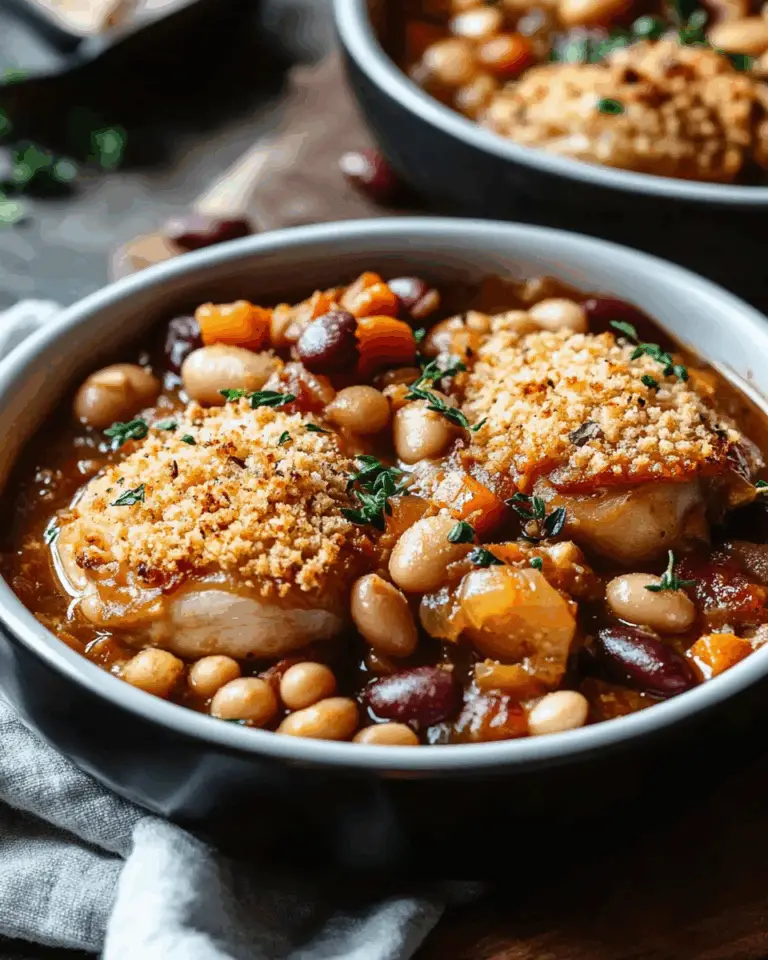Chicken Cassoulet is a rustic, slow-cooked French dish that brings together tender chicken thighs, white beans, and aromatic vegetables in a savory, herb-infused broth. Traditionally a comfort food, this hearty meal is ideal for a cozy family dinner or a make-ahead dish for entertaining. The optional panko topping adds a satisfying crunch to contrast the rich, tender stew beneath.
Full Recipe:
Ingredients
For the Chicken
-
4 bone-in, skin-on chicken thighs (or use skinless if preferred)
-
1 tbsp olive oil
-
Salt and pepper, to taste
-
1 tsp dried thyme
For the Cassoulet
-
1 cup dried white beans (such as Great Northern or cannellini beans)
-
1 large onion, diced
-
2 cloves garlic, minced
-
1 large carrot, diced
-
1 celery stalk, diced
-
1 can (14 oz) crushed tomatoes
-
4 cups chicken broth (preferably low-sodium)
-
1 bay leaf
-
2 tsp fresh thyme (or 1 tsp dried)
-
½ tsp dried rosemary
-
1 tbsp Dijon mustard
-
1 tbsp fresh parsley, chopped (for garnish)
Optional for Topping
-
½ cup panko breadcrumbs (for added crunch)
-
1 tbsp olive oil (for drizzling)
Directions
1. Prepare the Beans
Soak the dried white beans overnight in water, or use the quick soak method (boil for 2 minutes, then let sit covered for 1 hour). Drain and rinse before using.
2. Brown the Chicken
Season the chicken thighs with salt, pepper, and dried thyme. Heat 1 tbsp olive oil in a large Dutch oven or deep skillet over medium heat. Sear the chicken, skin side down, until golden brown (about 5–6 minutes per side). Remove and set aside.
3. Sauté the Vegetables
In the same pot, add onion, garlic, carrot, and celery. Sauté for 5–7 minutes until softened and fragrant.
4. Build the Cassoulet
Stir in the crushed tomatoes, soaked beans, chicken broth, bay leaf, thyme, rosemary, and Dijon mustard. Nestle the seared chicken thighs back into the pot.
5. Simmer and Cook
Bring the mixture to a boil, then reduce heat to low, cover, and simmer for 1.5 to 2 hours, or until the beans are tender and the chicken is fully cooked.
6. Optional Crunchy Topping
Preheat oven to 400°F (200°C). If using, mix panko with 1 tbsp olive oil and sprinkle over the cassoulet. Transfer the pot to the oven and bake uncovered for 10–15 minutes until the top is golden and crispy.
7. Serve
Garnish with fresh parsley and serve warm with crusty bread or a side salad.
Nutrients (per serving, approx. 6 servings)
-
Calories: ~420
-
Protein: 30g
-
Carbohydrates: 25g
-
Fat: 22g
-
Fiber: 6g
-
Sugar: 5g
-
Sodium: 580mg
A Culinary Tradition Steeped in History
The origins of cassoulet stretch back to the Middle Ages, born out of necessity and the rural practice of combining what was readily available—usually legumes, meats, and herbs—into a single, nourishing pot. The name “cassoulet” itself comes from the traditional earthenware pot it was baked in: the “cassole.”
As it gained popularity, regional variations developed across southern France. Castelnaudary, Toulouse, and Carcassonne all claim ownership of the definitive cassoulet, each incorporating different meats and ingredients unique to their locality. The chicken variation, while not part of the traditional trifecta, has gained favor for its lean protein and adaptability, especially in households looking for a slightly lighter or more economical version.
An Intricate Balance of Flavors and Textures
Chicken Cassoulet may appear simple, but its success lies in the layering of flavors and careful cooking process. Each component adds its own voice to the symphony. Chicken thighs, with their rich flavor and moist texture, are ideal for slow cooking, releasing their juices into the surrounding broth and helping to build a deep umami base.
The white beans play a dual role in the cassoulet. Not only do they absorb the surrounding flavors as they cook, but they also lend a creamy, hearty texture that makes the dish feel complete and satisfying. The beans soften gently during the cooking process, yet maintain enough structure to avoid turning into mush—perfectly complementing the tenderness of the chicken.
Aromatic vegetables like onion, garlic, carrot, and celery form the backbone of the flavor profile. These classic mirepoix ingredients are sautéed until their natural sugars are released, infusing the broth with warmth and subtle sweetness. The addition of herbs like thyme, rosemary, and a bay leaf deepens the complexity of the dish, while a touch of Dijon mustard adds just the right amount of sharpness to cut through the richness.
Optional Topping for a Textural Twist
One of the more contemporary touches in this Chicken Cassoulet recipe is the use of a crispy panko breadcrumb topping. While not a traditional component, this element adds a delightful contrast to the soft textures beneath. Once the cassoulet has simmered to perfection, sprinkling the surface with oil-tossed breadcrumbs and baking it briefly in the oven creates a golden, crunchy layer that elevates the dish.
This topping also serves as a bridge between the rustic cassoulet and modern casserole-style dishes. It provides both visual appeal and a textural surprise, making it particularly well-suited for dinner parties or potlucks, where presentation is almost as important as taste.
The Beauty of Slow Cooking
One of the most rewarding aspects of Chicken Cassoulet is the slow cooking process. While it requires time and patience, the method is largely hands-off, allowing flavors to meld and deepen as the dish gently simmers. The act of slow cooking brings out the best in each ingredient, turning even simple staples like beans and broth into a luxurious, cohesive meal.
For home cooks, this approach is not just about the result—it’s about the ritual. The aroma that fills the kitchen as the cassoulet simmers is almost as satisfying as the meal itself. It’s the kind of dish that encourages you to slow down, pour a glass of wine, and savor the experience of cooking as much as eating.
Versatility for Modern Living
Chicken Cassoulet is also remarkably adaptable. While the traditional recipe follows a certain structure, it leaves room for personalization based on what you have on hand or dietary preferences. You might substitute the chicken thighs with turkey, use canned beans instead of dried for convenience, or add a touch of smoked paprika or chili flakes for a subtle kick.
This flexibility makes Chicken Cassoulet not just a recipe, but a method—a template you can return to again and again, modifying it slightly each time to suit the season or your mood. It’s a dish that evolves with your kitchen, your pantry, and your lifestyle.
Serving Suggestions and Pairings
A steaming bowl of Chicken Cassoulet is a complete meal in itself, but it pairs beautifully with rustic accompaniments. A loaf of crusty French bread is a natural choice, ideal for soaking up the rich broth. A simple green salad dressed with a sharp vinaigrette can provide a refreshing counterbalance to the dish’s depth.
For beverages, a medium-bodied red wine such as a Côtes du Rhône or a Pinot Noir complements the flavors without overwhelming them. Alternatively, a dry hard cider or even a farmhouse-style beer adds an earthy, fermented note that harmonizes with the rustic character of the cassoulet.
A Dish That Feeds the Soul
What sets Chicken Cassoulet apart from other stews and casseroles is its soulful character. This is not a quick weeknight meal to be rushed through but rather a dish that invites connection—with tradition, with the act of cooking, and with those you share it with. It encourages mindfulness, from the thoughtful layering of ingredients to the slow bubbling of the pot.
It’s also a dish that seems to taste even better the next day, making it a great candidate for batch cooking or meal prep. As the ingredients continue to marry in the refrigerator, the flavors become deeper, more unified, and even more comforting. Reheated gently, it can serve as a reminder that some things truly do get better with time.
Conclusion
Chicken Cassoulet is more than just a recipe—it is a tribute to the heart and soul of French country cooking. It brings together humble ingredients and transforms them into something rich, nourishing, and deeply flavorful. Its slow-cooked nature teaches patience, while its aroma and taste reward that patience tenfold. Whether you’re seeking a comforting family dinner, an impressive make-ahead meal for guests, or simply a way to connect with timeless culinary traditions, Chicken Cassoulet delivers. Its legacy may be centuries old, but its appeal is as fresh and satisfying today as ever.






